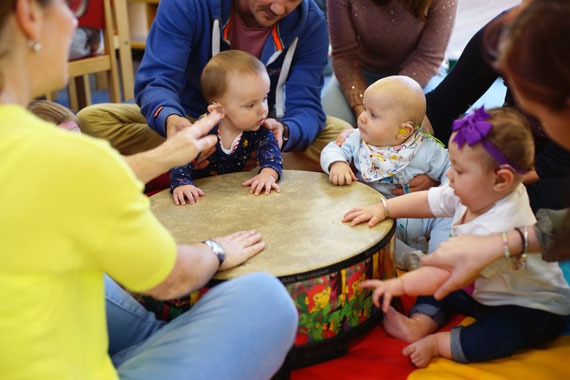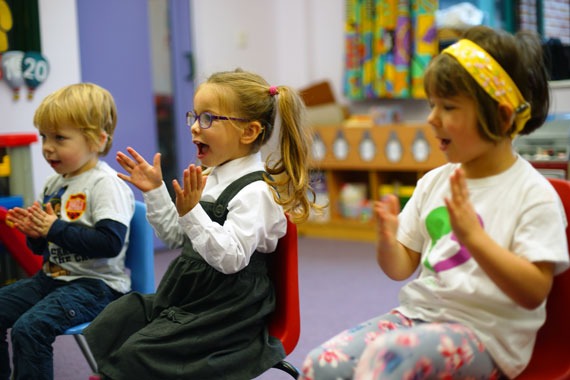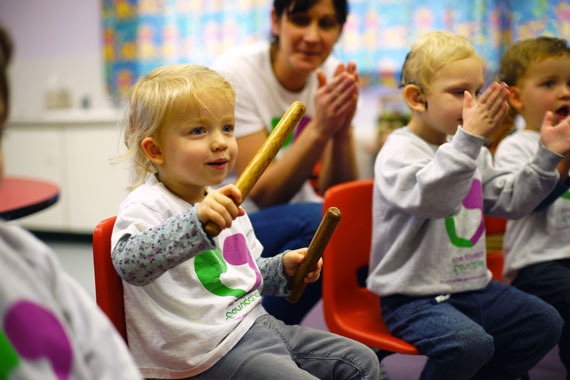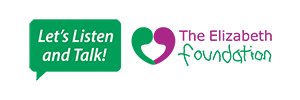Foundations for communication
Tips, advice and guidance from The Elizabeth Foundation to help young deaf children develop their listening and talking skills.
Music matters – how music helps preschool deaf children learn
“Music training is a more potent instrument than any other, because rhythm and harmony find their way into the inward places of the soul on which they mightily fasten.” Plato (The Republic, Book III)
Music is an extremely useful and effective way to help young children who are deaf develop their listening and talking skills. In this blog post we are going to take a look at why music is so important, and the many ways you can use music and singing to help your deaf baby, toddler or preschooler learn.
But before we get any further, we’d just like to reassure you that you do not have to be a good singer or a musician to develop your deaf child’s listening and language skills with songs and music. You just need to be willing to give it a go and help your child to join in.
Learning through music
For young children with any degree of deafness, so much of their learning can take place naturally all-day, every day, particularly for developing speaking and listening skills. Music can play a major role in doing this and is an integral part of our programme we share with parents here at The Elizabeth Foundation.
Music makes learning fun
Most children love music, musical games and the actions that go with many familiar songs and nursery rhymes. Whatever their degree of deafness, children love the fun, energy and excitement that accompany singing songs, playing instruments and sharing music. And as we know, children learn best when they are enjoying themselves!
How music can help your child learn
Music can help with early language development and can provide positive emotional experiences between you and your child from their earliest days.
Before babies understand words, they tune into your musical ‘sing-song’ voice. This keeps their attention for longer periods of time and creates lots of fun communication experiences. And by singing, looking, moving, etc, you are making the activities a multi-sensory learning experience.
The basics of music have a lot to do with early language development. Babies and toddlers tune into your voice, your tone and your facial expressions. So even though they don’t understand the language, they get a lot of information in these other ways.
The fact that many early songs and nursery rhymes are repetitive helps children hear things many times, so that they can learn them and remember them. Music, singing and song time are really good ‘social times’ for your child that helps them learn a lot about how to share and enjoy activities together.
Why music is important
Music and songs can have a positive impact on children’s development – particularly on their listening, language and social skills. For deaf children, the rhythm, repetitions and pitch of music and songs can also help them develop more natural-sounding language.
How music helps children’s development
- Most young children love music and so it provides tremendous potential for learning and development. Research shows that listening to and making music activates multiple areas of the brain important for language development. It can also improve memory, vocal emotion, attention and understanding speech in noise.
- Music and songs help young children learn about tones and rhythm – when babies are learning language they tune into pitch, tone and volume variations as these can convey a great deal of information even when we don’t understand the words of a message.
- Songs grab a child’s attention and provide an opportunity to acquire new words. Music also impacts on language and memory as it provides an opportunity to develop and extend a child’s vocabulary through repetition in meaningful ways.
- Music helps develop social relationships as it provides a time for togetherness; a time to bond and a time to connect with a group in a shared activity. Young children learn about turn-taking, joining in and anticipation.
- Rhymes and songs are a great way of starting communication and sustaining attention. They can liven up daily repetitive routines such as clearing up and washing hands.
- Rhymes and song help to combine physical action and listening to help carve out neural pathways for learning.
Music helps deaf children develop natural language
For deaf children, alongside all of the other benefits we have just mentioned, music also provides excellent opportunities to help them develop more natural-sounding language.
Language is full of musical characteristics which give it expression and meaning, and make it interesting to the listener. Children with any degree of deafness need additional opportunities to experience these elements in different ways to help them develop natural-sounding speech.
Music and songs provide opportunities for your child to practise:
- Rhythm: we all speak rhythmically – without rhythm, our speech would be dull and monotone.
- Pitch: the rise and fall of our voice is important for expressing emotion and meaning.
- Sound discrimination: music can help your child learn to hear the differences between different sounds.
- Breath control: this is important for your child to develop a strong voice with good voice quality.
Music and songs can also encourage:
- Concentration: because songs are fun, whilst your child is enjoying the music and activity they will focus for longer periods of time
- Confidence: joining in with the actions and singing together will help develop confidence and a willingness to give things a go.
- Gross motor skills: the actions that accompany many songs and nursery rhymes can help your child’s co-ordination
- Social skills: as noted above, musical activities encourage turn-taking, call-and-response “conversations”, and interactions with family and friends
How to use music with your child
Singing and all types of musical activities with babies, toddlers and preschoolers can be really enjoyable – and also can make a significant impact on their natural language skills. Music-based activities can also be an excellent way for the family, including any siblings, to relax together, to bond together and to simply enjoy being together.
Here are some tips to help you focus on different areas of listening and speech with your child.
Just dive in!
If music is not something you are particularly comfortable with, rest assured that your child will love whatever you do. They will be your least harsh critic so just give it a go and try to enjoy it too!
You do not have to be a musician, a good singer or an expert to develop your child’s musical ability. But you do need to give your child the opportunity to experience music, sounds and songs so they can develop the skills and tools to participate in a meaningful way themselves.
Music with your child can include CDs or streamed music, YouTube videos, nursery rhyme books, singing, noisy instruments and a lot of fun! Explore lots of different ways to enjoy music together.
Focusing on different aspects of listening and language through music
We’ll now take a look at some different areas of your child’s listening and language skills that you can encourage through music, along with some examples and reasons for carrying out each activity. These activities are for all ages, so some might be a bit young for your child and some might seem a bit old. However, we have left them all in so that you can think of ways to enjoy music as a family (including any younger or older brothers and sisters).
When using these musical activities, remember that children with any degree of deafness learn most effectively with lots of repetition and additional time to respond.
Rhythm
We all speak rhythmically. Without any rhythm, our speech would be dull and monotonous. You can encourage rhythm in your child’s language by:
- beating the syllables of your child’s own name/family names on a drum
- clapping along to music with a strong beat
- copying rhythmic patterns with clapping, or hitting pots/metal lids/plastic tubs with wooden spoons
- patting knees, shaking arms, clapping hands, rocking from side to side, walking, running – or even galloping like a horse…
Sound awareness/auditory training
Actively listening to the presence and absence of sound encourages good listening skills. You can promote your child’s sound awareness by:
- jumping from one mat to another on a given signal (such as shaking a shaker, banging a drum, clapping, or saying ‘go’)
- playing musical bumps or musical statues (on/off of music) – move to music and then sit or stop when music stops – you can even play musical chairs with family/siblings/friends
- placing a play-brick or toy in a bucket on a given signal (shaker, drum, clap, ‘go’)
- exploring household sounds – such as switching the vacuum cleaner on and off and focusing on the difference between the noise and the silence
Breath control
Helping your child improve their breath control will help your child to develop a strong voice, which will improve voice quality. You can improve your child’s breath control through:
- blowing bubbles
- playing with party blowers
- using any form of ‘blowing’ instrument – toy trumpet, recorder, horn, etc – practice copying rhythms such as continuous and abrupt/short
Rhyming words – traditional nursery rhymes
There are many traditional nursery songs with lovely rhyming words which are fun to sing and also part of natural childhood.
Make a picture book with a picture along with a song title on each page to represent traditional nursery songs so your child can choose a song – you can build this up over time as your child learns new songs.
Use props/pictures/actions to give additional clues about the language that goes with the song – for example:
- toy bus – Wheels on the Bus
- toy sheep – Baa-Baa Black Sheep
- star – Twinkle-Twinkle Little Star
- toy spider – Incy-Wincy Spider
Movement and sound discrimination
You can use songs, music and nursery rhymes to explore differences in sound and to improve gross motor skills and co-ordination. You can encourage movement and sound discrimination by:
- singing action songs – e.g. the Hokey-Cokey, Ring-a-Ring-of-Roses
- moving to sound – e.g. fast to fast sound/music; slow to slow sound/music; big movements for loud sound/music and little movements for soft sound/music
- making movements appropriate to the sounds: for example, jumping like a frog to abrupt sound (e.g. a horn) and slithering like a snake to a continuous sound (e.g. a shaker)
Exploring and ‘feeling’ sound with instruments
There are lots of lovely and easy-to-find or easy-to-make “instruments” you can use. You and your child can experiment with these instruments to ‘feel’ the sound of drums and chimes and explore pitch and rhythm. For example, you can:
- play along to taped music and stop when music stops
- explore new instruments – how is the sound made – plucking, shaking, banging, etc
- discover ways of making sound with household objects – such as pots and bans or empty plastic food containers/bottles
- make musical instruments – plastic bottles made into shakers with different things inside to make different sounds – rice, pasta, beans, etc
Building literacy through music
Use elements of singing and music (pitch, rhythm, speed, loudness, etc) when reading books with your child (and any siblings):
- Billy Goats Gruff – big, medium, small – loud, medium, quiet
- Goldilocks and the Three Bears – low pitch, medium pitch, high pitch/big, medium, small/loud, medium, quiet
- The Three Pigs – rhythm (“I’ll huff, and I’ll puff and I’ll blooooow your house down!”)
- The Gingerbread Man – rhythm (“Run, run as fast as you can, you can’t catch me, I’m the gingerbread man!”)
- Jack and the Beanstalk – pitch moving up; pitch moving down; loud/quiet; fast/slow
What are we hoping to see?
Depending on your child’s age and stage of development, their reaction to music and songs will usually proceed along the following lines:
- To begin with, your child will watch you and the actions that you make.
- After a while they should start to copy a few of the actions or anticipate the next parts of the song.
- Once your child is more familiar with the song they might use a few of those actions to tell you which song they want to sing.
- Next, your child might use their voice to ‘sing along’, not using words, but displaying some rhythm and/or pitch.
- Later you might hear your child using a few single words, such as “star” for Twinkle-Twinkle Little Star, or “baa” for Baa-Baa Black Sheep.
- And, in the longer term, your child might even try to fill in words and lines, respond appropriately (eg when you sing “If you’re happy and you know it”, they might clap their hands and say “Clap your hands”), or even have a go at singing the whole song or nursery rhyme.
Summary - Music matters for deaf children:
- Music is an effective way to help deaf babies and young children to develop their communication skills.
- Research shows that listening to and making music activates multiple areas of children’s brains important for auditory, language and cognitive development.
- Through music, you can learn pre-verbal communication skills that lay the foundation for verbal communication.
- Songs, nursery rhymes and music also provide opportunities for deaf children to develop their vocabulary, social skills, memory, breath control and gross motor (body control/movement) skills
- For deaf children, the rhythm, repetition and varying pitch/tone of music and songs can help them to develop more natural-sounding speech.

Why does music matter?
In this video, Chris Rocca, specialist music therapist, explains why music matters and how you can use it to help your child develop their listening and talking skills.

Recommended reading
For some of the science behind the ways in which music can help development for preschool deaf children, take a look at these research articles:
- Nelson et al. (2015) Embedding music into language and literacy instruction for young children who are deaf or hard of hearing https://doi.org/10.1177/1096250614566539 (free)
- Rocca (2015) Developing the musical brain to boost early pre-verbal, communication and listening skills: the implications for musicality development pre- and post-cochlear implantation. It is not just about Nursery Rhymes! https://doi.org/10.1179/1467010015Z.000000000277 (requires payment to access)
- Torppa and Huotilainen (2019) Why and how music can be used to rehabilitate and develop speech and language skills in hearing-impaired children https://doi.org/10.1016/j.heares.2019.06.003 (free)

Let's Listen and Talk
A practical music programme to use with your deaf child
If you’re not sure how to get started, the “Learning through music” section of Let’s Listen and Talk offers a structured series of easy-to-learn and fun-to-use songs to promote language development for babies and young children with any degree of deafness from birth to 5 years. The range of songs have been specially designed to cover all the different aspects of listening and language development mentioned above.
Working with the expert creators of the popular BabyBeats™ programme (Chris Rocca and Cathy Bowker), we developed new songs with actions that you can use at home with your deaf child. The “Learning through music” resource is a further development of the BabyBeats™ approach, and draws on our extensive practical experience of running music groups with families here at The Elizabeth Foundation.
This resource is freely-accessible to anyone who signs up to any of our Let’s Listen and Talk Baby, Toddler and Preschool programmes. Each of these programmes also includes additional music-based activities.
An example Let's Listen and Talk song
Five little fingers – introduction
In this video, specialist music therapist Chris Rocca introduces the ‘Five little fingers’ song - which was developed for toddlers (1½ - 2½ years old).
Five little fingers – demonstration
In this video, Chris Rocca demonstrates the ‘Five little fingers’ song.
‘Five little fingers’ – home video
Here is home video of a parent and child using this song:
To see more songs, go to Learning through music – Lets Listen and Talk

Useful links
- Learning through music – Lets Listen and Talk
- BabyBeats (advancedbionics.com) – a series of music activities for deaf babies




